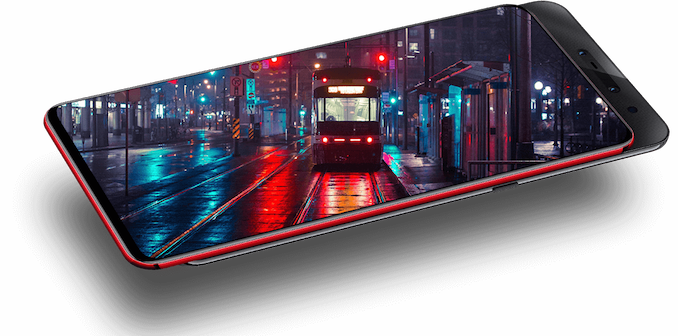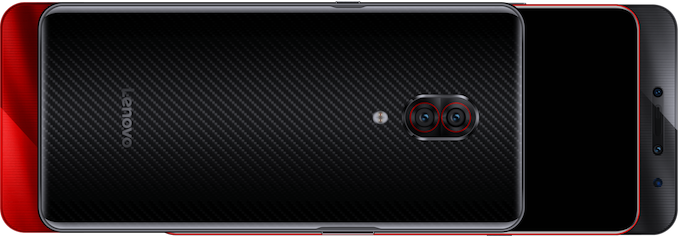Lenovo First to a Snapdragon 855 Phone with Announcement of Z5 Pro GT
by Andrei Frumusanu on December 18, 2018 10:00 AM EST- Posted in
- Smartphones
- Lenovo
- Mobile
- Snapdragon 855
- Z5 Pro

In a surprise announcement, Lenovo has revealed its new flagship phone in China: the new Z5 Pro. The phone wouldn’t have been anything particularly special if it weren’t for the fact that Lenovo is also offering a “GT” version of the model which comes with the new Qualcomm Snapdragon 855. Effectively, this makes the Z5 Pro GT the very first S855 phone announced, and what seems to be also the first phone with the chipset that will be available for consumers.
| Lenovo Z5 Pro | ||
| Z5 Pro | Z5 Pro GT | |
| SoC | Snapdragon 710 2x Kryo 360 (CA75) @ 2.2GHz 6x Kryo 360 (CA55) @ 1.7GHz Adreno 616 |
Snapdragon 855 1x Kryo 485 Gold (A76 derivative) @ 2.84GHz 1x512KB pL2 3x Kryo 485 Gold (A76 derivative) @ 2.42GHz 3x256KB pL2 4x Kryo 485 Silver (A55 derivative) @ 1.80GHz 4x128KB pL2 2MB sL3 Adreno 640 |
| Display | 6.39-inch 2340x1080 (19.5:9) Samsung AMOLED |
|
| Dimensions | 155.12 x 73.04 x 9.3 mm 210g |
|
| RAM | 6GB LPDDR4X | 6GB / 8GB LPDDR4X |
| NAND | 64GB / 128GB | 128GB / 256GB |
| Battery | 3350mAh (12.89Wh) non-replaceable |
|
| Front Cameras | 16MP regular camera | |
| 8MP infrared camera | ||
| Rear Cameras | 24.8MP Sony IMX576 0.9µm pixel native / 1.8µm pixels in 6.2MP pixel binning f/1.8 aperture |
|
| 16MP Sony IMX519 1.22µm pixels f/1.8 aperture |
||
| Modem | Snapdragon X20 LTE (Integrated) 2G / 3G / 4G LTE (Category 16/13) |
|
| SIM Size | NanoSIM | |
| Wireless | 802.11a/b/g/n/ac 2x2 MU-MIMO, BT 5.0 LE, NFC, GPS/Glonass/Galileo/BDS |
|
| Connectivity | USB Type-C | |
| Features | Under-screen fingerprint sensor, no-notch sliding screen design | |
| Launch OS | ZUI10 based on Android 8.1 | |
Lenovo has launched the Z5 Pro in two variants; on the outside both units seemingly look pretty much the same and overall share the large majority of hardware specifications between them. Where the GT version differs is the fact that it uses a higher end SoC. The regular Z5 Pro comes with a Snapdragon 710, which represents Qualcomm’s new “premium” tier SoC offering that is meant to bring flagship-like features yet coming at a lower price point. The compromise here is in performance as the 2+6 CPU configuration in the form of 2.2GHz A75 derived cores and 1.7GHz A55 derived cores doesn’t match the bigger and more capable 1+3+4 configuration of the Snapdragon 855.
The regular version only comes in a 6GB RAM configuration in either 64GB or 128GB storage variants, while the GT version also offers 6GB or 8GB options that come with the 128GB storage variant, and additionally has an 8GB/256GB SKU.
The core design aspect of the Z5 Pro is the fact that this is a full-screen bezel-less design that is achieved through a sliding screen mechanism. Lenovo isn’t the first to such a smartphone as Honor with the Magic 2 was the first, and also Xiaomi has followed suit with the Mi MIX 3. In fact, the Lenovo Z5 Pro is eerily similar with the Honor Magic 2 and Xiaomi Mi MIX 3 in this regard: All three have the exact same 6.39” 2340x1080 Samsung AMOLED screen specifications. In fact, I wouldn’t be surprised if this were the same display panel across all three phone brands.
While the sliding screen mechanism does allow for a bezel-less experience as the main front cameras are found on the main chassis underneath the screen, the disadvantage of this design is that it introduces a quite significant amount of heft to the phone – as similarly to the Magic 2 and MIX 3, the Z5 Pro is quite thick and heavy at 9.3mm and 210g – all while having a relatively regular 3350mAh battery.
On the camera side, the Z5 Pro offers two front cameras and two rear cameras. The two front units come with a configuration of a regular 16MP sensor as well as an 8MP infra-red unit. Lenovo doesn’t seem to provide more specifics on the front units, but goes into more detail on the rear cameras.
The rear units consists of two Sony sensors, one 24.8MP IMX576 and one 16MP IMX519. The configuration is quite odd here as the sensors don’t appear to be offering different lens configurations – both are advertised as f/1.8 aperture units. Lenovo advertises greater light capture ability on the part of the 24.8MP sensor by achieving 2x2 pixel binning, resulting in an effective pixel pitch of 1.8µm.
The phone’s other features includes an under-screen fingerprint sensor, and unfortunately that’s about it. The main connector is USB-C, and the device lacks other specifications such as a 3.5mm headphone jack, and the sliding screen mechanism also makes it hard for the phone to support any kind of IP rating. There’s also no wireless charging.
Lenovo will starts offering pre-orders on the 20th of December and promises delivery within 7 days. The big catch here of course is that the phone will be mainly available in China and doesn’t represent a viable option for western customers as it lacks the needed LTE frequency bands.













33 Comments
View All Comments
PeachNCream - Tuesday, December 18, 2018 - link
That's a huge screen. Reducing the size a bit would eliminate the need for a potentially failure-prone sliding mechanism and likely increase battery life.Dragonstongue - Tuesday, December 18, 2018 - link
no kidding, monster screen, fairly small battery for that size...I wish these "top makers" would stop putting such small batteries A and B stop the BS of "non replaceable" when so damn small.If it were say 7000mAh, I could understand, but not something below 4000 that is damn sure
ionuts - Tuesday, December 18, 2018 - link
1080p (albeit 19.5:9), AMOLED. I think there's plenty of juice in that battery to last throughout the day.melgross - Tuesday, December 18, 2018 - link
AMOLED is no more efficient than LCD, possibly less efficient. Don’t believe the hype.sing_electric - Wednesday, December 19, 2018 - link
Screen resolution isn't nearly as important to battery life as screen size. Yes, lower res = less work for the GPU, but ultimately, the screen still needs to put out X lumens of light across a given area. More area = more power.drajitshnew - Tuesday, December 18, 2018 - link
Dragons, unfortunately the phones with good battery life have a POS SOCMrSpadge - Thursday, December 20, 2018 - link
Consider the Pocophone F1.Andrei Frumusanu - Tuesday, December 18, 2018 - link
Keep in mind what matters here is the width; in terms of form-factor it's no different than a Galaxy S9+.sing_electric - Wednesday, December 19, 2018 - link
I actually wonder if the screen argument runs the OTHER direction: The # of components in the sliding mechanism makes it impractical for smaller screen sizesPeachNCream - Wednesday, December 19, 2018 - link
I don't know how the sliding mechanism is constructed in the Lenovo example in this article, but I did at one point own a slider running Android 2.2 with a 3.2 inch screen - an LG Optimus Slider...it worked relatively well and was maybe had 1/3rd of the length and width of this phone.